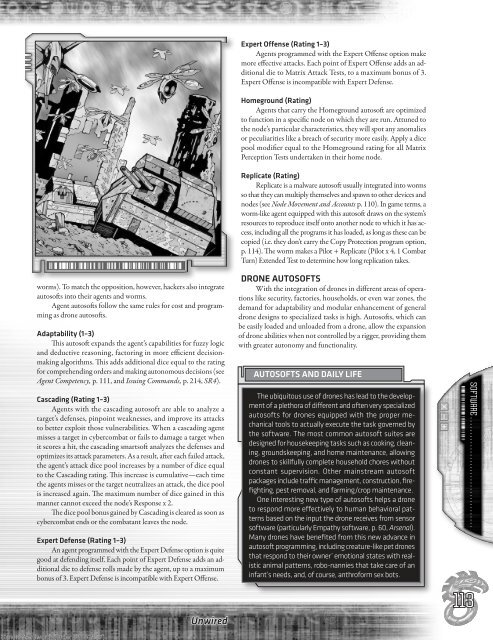comStar Firewall alert - PhaseThrough
comStar Firewall alert - PhaseThrough
comStar Firewall alert - PhaseThrough
You also want an ePaper? Increase the reach of your titles
YUMPU automatically turns print PDFs into web optimized ePapers that Google loves.
worms). To match the opposition, however, hackers also integrate<br />
autosofts into their agents and worms.<br />
Agent autosofts follow the same rules for cost and programming<br />
as drone autosofts.<br />
adaptability (1–3)<br />
This autosoft expands the agent’s capabilities for fuzzy logic<br />
and deductive reasoning, factoring in more efficient decisionmaking<br />
algorithms. This adds additional dice equal to the rating<br />
for comprehending orders and making autonomous decisions (see<br />
Agent Competency, p. 111, and Issuing Commands, p. 214, SR4).<br />
cascading (rating 1–3)<br />
Agents with the cascading autosoft are able to analyze a<br />
target’s defenses, pinpoint weaknesses, and improve its attacks<br />
to better exploit those vulnerabilities. When a cascading agent<br />
misses a target in cybercombat or fails to damage a target when<br />
it scores a hit, the cascading smartsoft analyzes the defenses and<br />
optimizes its attack parameters. As a result, after each failed attack,<br />
the agent’s attack dice pool increases by a number of dice equal<br />
to the Cascading rating. This increase is cumulative—each time<br />
the agents misses or the target neutralizes an attack, the dice pool<br />
is increased again. The maximum number of dice gained in this<br />
manner cannot exceed the node’s Response x 2.<br />
The dice pool bonus gained by Cascading is cleared as soon as<br />
cybercombat ends or the combatant leaves the node.<br />
expert defense (rating 1–3)<br />
An agent programmed with the Expert Defense option is quite<br />
good at defending itself. Each point of Expert Defense adds an additional<br />
die to defense rolls made by the agent, up to a maximum<br />
bonus of 3. Expert Defense is incompatible with Expert Offense.<br />
Unwired<br />
expert offense (rating 1–3)<br />
Agents programmed with the Expert Offense option make<br />
more effective attacks. Each point of Expert Offense adds an additional<br />
die to Matrix Attack Tests, to a maximum bonus of 3.<br />
Expert Offense is incompatible with Expert Defense.<br />
Homeground (rating)<br />
Agents that carry the Homeground autosoft are optimized<br />
to function in a specific node on which they are run. Attuned to<br />
the node’s particular characteristics, they will spot any anomalies<br />
or peculiarities like a breach of security more easily. Apply a dice<br />
pool modifier equal to the Homeground rating for all Matrix<br />
Perception Tests undertaken in their home node.<br />
replicate (rating)<br />
Replicate is a malware autosoft usually integrated into worms<br />
so that they can multiply themselves and spawn to other devices and<br />
nodes (see Node Movement and Accounts p. 110). In game terms, a<br />
worm-like agent equipped with this autosoft draws on the system’s<br />
resources to reproduce itself onto another node to which it has access,<br />
including all the programs it has loaded, as long as these can be<br />
copied (i.e. they don’t carry the Copy Protection program option,<br />
p. 114). The worm makes a Pilot + Replicate (Pilot x 4, 1 Combat<br />
Turn) Extended Test to determine how long replication takes.<br />
drone aUtoSoftS<br />
With the integration of drones in different areas of operations<br />
like security, factories, households, or even war zones, the<br />
demand for adaptability and modular enhancement of general<br />
drone designs to specialized tasks is high. Autosofts, which can<br />
be easily loaded and unloaded from a drone, allow the expansion<br />
of drone abilities when not controlled by a rigger, providing them<br />
with greater autonomy and functionality.<br />
aUtoSoftS and daiLY Life<br />
The ubiquitous use of drones has lead to the development<br />
of a plethora of different and often very specialized<br />
autosofts for drones equipped with the proper mechanical<br />
tools to actually execute the task governed by<br />
the software. The most common autosoft suites are<br />
designed for housekeeping tasks such as cooking, cleaning,<br />
groundskeeping, and home maintenance, allowing<br />
drones to skillfully complete household chores without<br />
constant supervision. Other mainstream autosoft<br />
packages include traffic management, construction, firefighting,<br />
pest removal, and farming/crop maintenance.<br />
One interesting new type of autosofts helps a drone<br />
to respond more effectively to human behavioral patterns<br />
based on the input the drone receives from sensor<br />
software (particularly Empathy software, p. 60, Arsenal).<br />
Many drones have benefited from this new advance in<br />
autosoft programming, including creature-like pet drones<br />
that respond to their owner’ emotional states with realistic<br />
animal patterns, robo-nannies that take care of an<br />
infant’s needs, and, of course, anthroform sex bots.<br />
Simon Wentworth (order #1132857) 9<br />
113<br />
software . . . . . . . . . . . . . . . . . . . . . . . . . . . . . . . . . . . .


